Evelyn: Hi Stephen, I'm doing some research on choosing the right scope reticle for my rifle. Do you have any experience with that?
Stephen: Yes, I've been shooting for years and have tried different types of reticles. What do you want to know?
Evelyn: Well, I'm not sure which one to choose. There are so many types and each seems to have its own benefits and drawbacks.
Stephen: That's true. The first thing you need to consider is the type of shooting you'll be doing. Different types of reticles are better suited for different types of shooting scenarios.
Evelyn: I see. What types of reticles would you recommend for hunting?
Stephen: For hunting, there are some simple reticles like crosshair reticles, center dot reticles, duplex reticles and German #4 reticles. They are mainly simple crosshair designs, some with thicker lines at the edges, and a central aiming point. The thicker lines at the edges can draw your eyes to the center of your target, especially in low light or busy background, thus helping you quickly acquire your target.
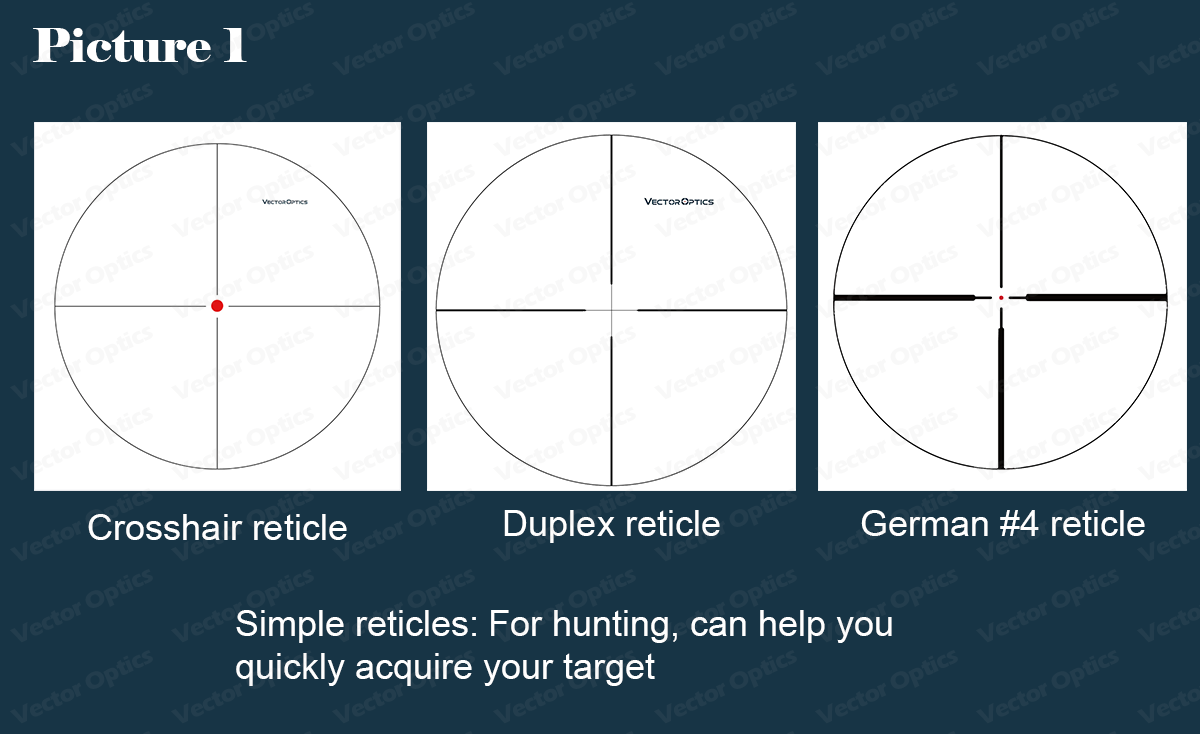
Evelyn: Okay, but what about BDC reticles? I also see them in hunting scopes.
Stephen: BDC (Bullet Drop Compensation) reticles are another popular choice for hunters and tactical shooters. They are designed to compensate for bullet drop at different ranges. BDC reticles are typically calibrated to a specific caliber and bullet weight, so it's important to match the reticle to the ammunition being used. BDC reticles feature marks or dots that correspond to specific ranges, allowing shooters to adjust their aim accordingly. These reticles are particularly useful when shooting at targets at varying distances, making them popular among hunters and long-range shooters.
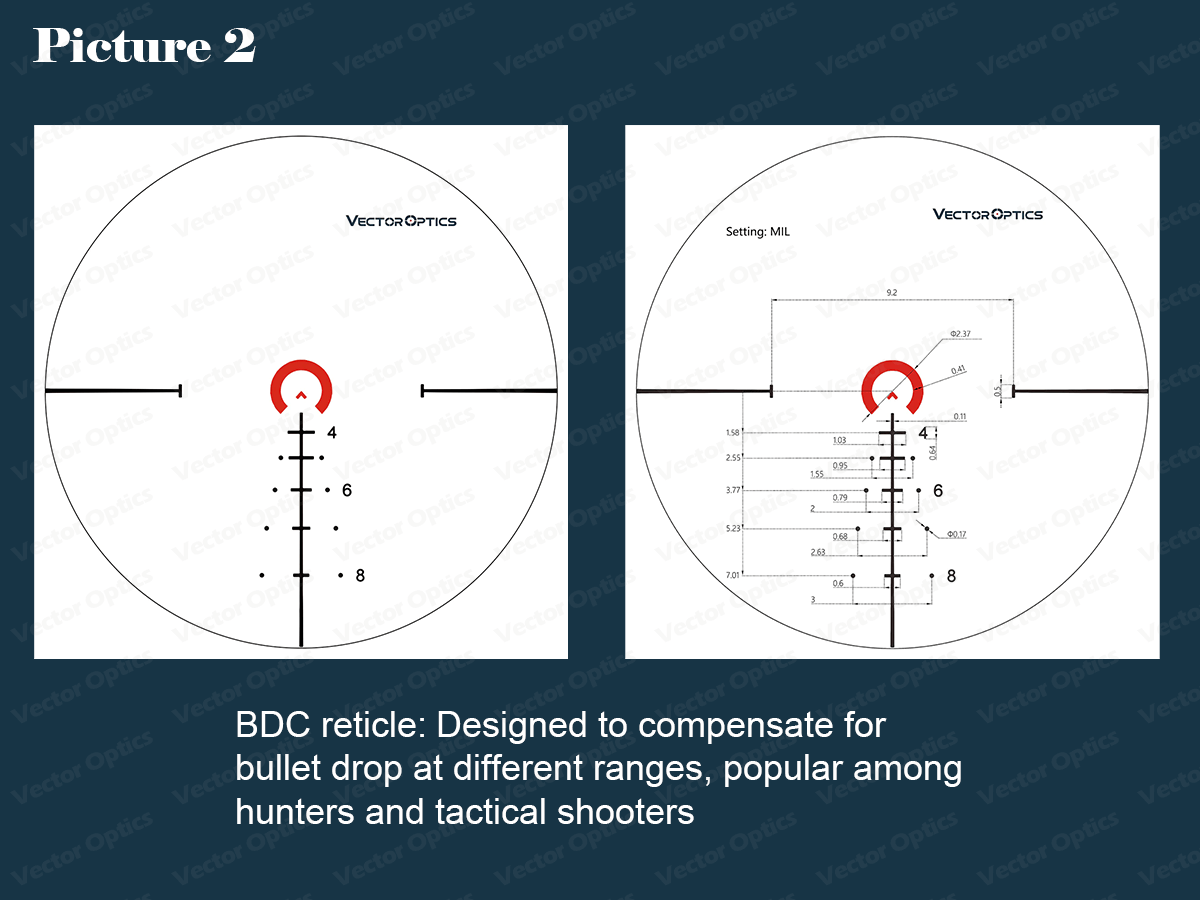
Evelyn: Got you. So for tactical shooting BDC reticle would be a good choice, what else?
Stephen: For tactical shooting, Mil-Dot reticles are one of the most popular reticles. The Mil-Dot reticle is a common choice for long-range shooting. It features evenly-spaced dots along the crosshairs, which can be used to estimate the range of your target. The dots are spaced one milliradian (or mil) apart, which corresponds to 3.6 inches at 100 yards. This makes it easy to calculate holdover and windage adjustments, as well as to estimate range.
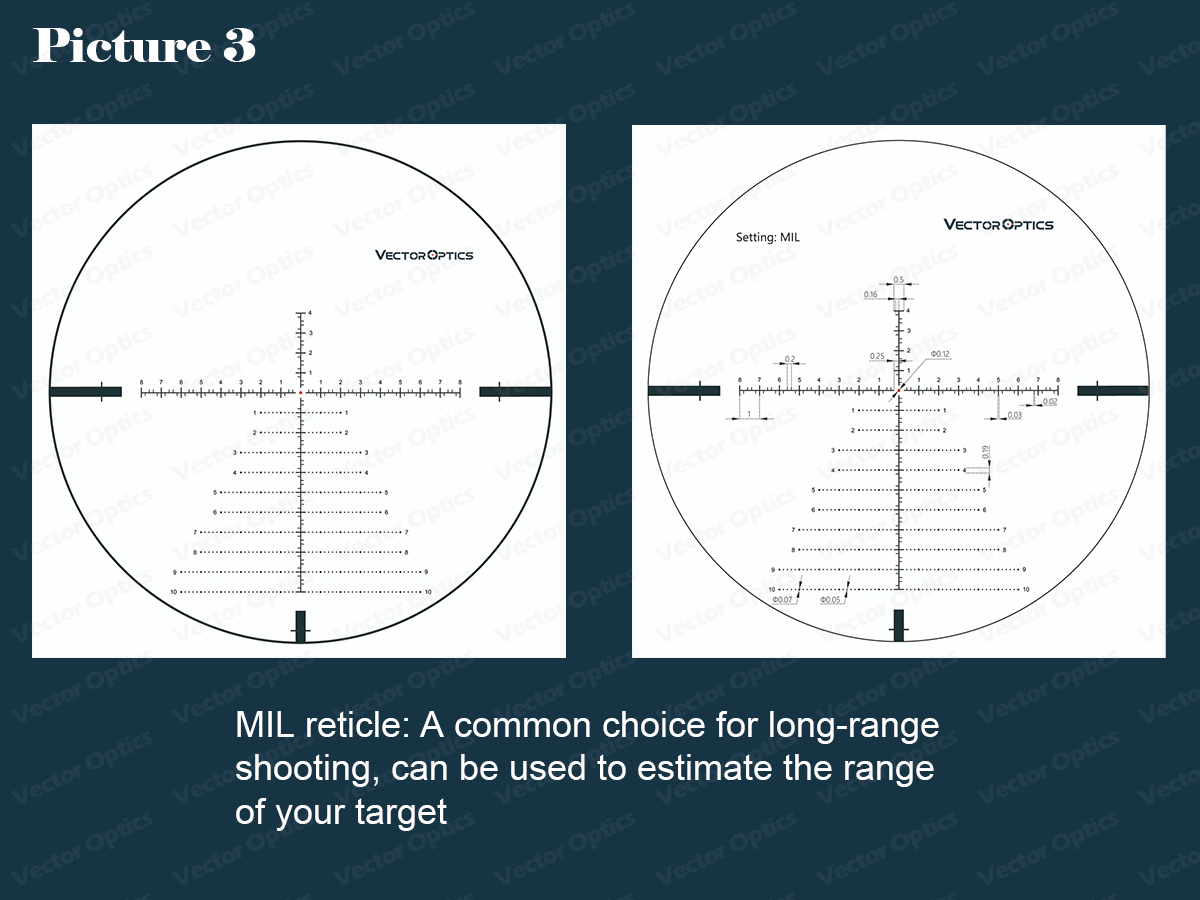
Evelyn: Okay, I'll keep that in mind. What about MOA reticles?
Stephen: The MOA reticle uses Minute of Angle (MOA) measurements, which correspond to 1.047 inches at 100 yards. This reticle is often preferred by hunters and precision shooters, as it allows for more precise adjustments and easier target acquisition. MOA reticles are also more intuitive for those who are already familiar with minute of angle measurements.
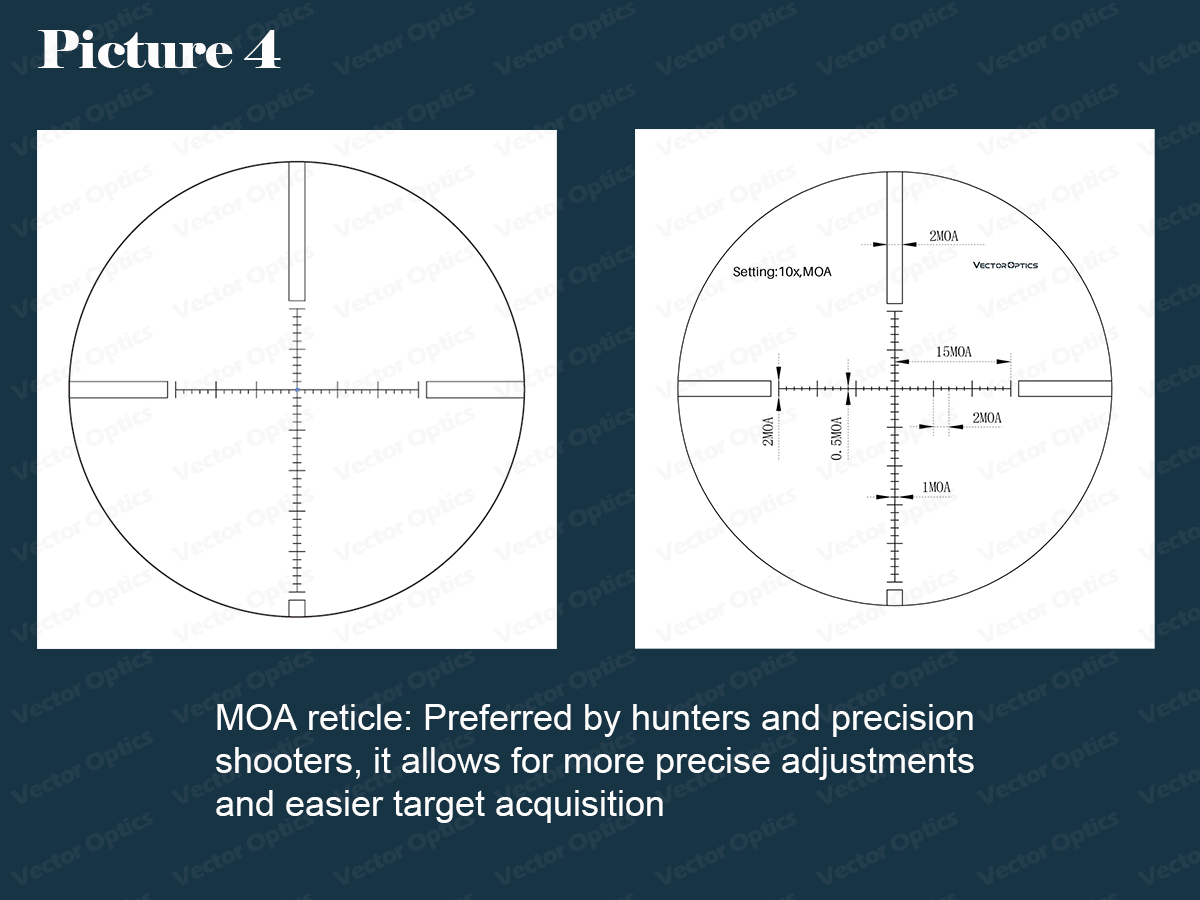
Evelyn: I see. Between Mil-Dot reticle and MOA reticle, which one would you recommend?
Stephen: The choice between Mil-Dot reticles and MOA reticles comes down to personal preference and intended use. If you are looking for a reticle that allows for easy range estimation and holdover adjustments, the Mil-Dot reticle may be your best bet. If you prioritize precision and ease of use, the MOA reticle may be a better choice. MIL or MRAD and CM are more suitable for those using the metric measurement system, while MOA is more suitable for those using the imperial measurement system.
Evelyn: Okay. But what about illuminated reticles? Are they worth the extra cost?
Stephen: Illuminated reticles are designed to provide better visibility in low light conditions such as dawn, dusk, or night time. However, they can also be used during the day time, especially at low magnification settings. This is especially important for hunters or shooters who need to quickly adapt to changing conditions. If the reticle is fiber-illuminated, then it can even be seen in very bight conditions. To some extend, illuminated reticles can be used as a substitute for red dot sights.
Evelyn: Got ya. And what about the FFP reticle and the SFP reticle?
Stephen: To choose between the two reticles, let’s first talk about their main features. The FFP reticle is placed at the front of the magnification lens, allowing for the same holdover and windage marks on the reticle at any magnification level. This makes it easier to estimate range and compensate for bullet drops and wind drift. However, the reticle can become too small or too large at extreme magnifications. Scopes with the FFP reticle are ideal for competitive shooting and hunting, where targets may be encountered at various distances and where speed and accuracy are important.
Evelyn: And what about the SFP reticle? What are the main features?
Stephen: The SFP reticle has a fixed size, making it clear and visible at any magnification level, but require a specific magnification level(usually the highest) for accurate holdover and windage marks. They are advantageous for benchrest shooters and those shooting fixed distances.
Evelyn: I see. So how to choose between the FFP and the SFP reticle?
Stephen: Scopes with the FFP reticle are useful in shooting scenarios where targets are at various distances and where speed and accuracy are important, such as in PRL(Precision Rifle League) and NRL(National Rifle League) shooting, and 3 Gun Events. They allow the shooter to vary the magnification on the fly and engage targets utilizing holdover at any magnification and distance. Scopes with the SFP reticle, on the other hand, are advantageous for benchrest shooting or any situation where you will routinely shoot at a fixed distance.
Evelyn: Now I know that when choosing different reticles, one needs to mainly consider different shooting scenarios, MIL or MOA, FFP or SFP and illuminated or non-illuminated, and choose one that best fits your shooting needs. Am I right?
Stephen: That’s right. Check out the chart below for reference.
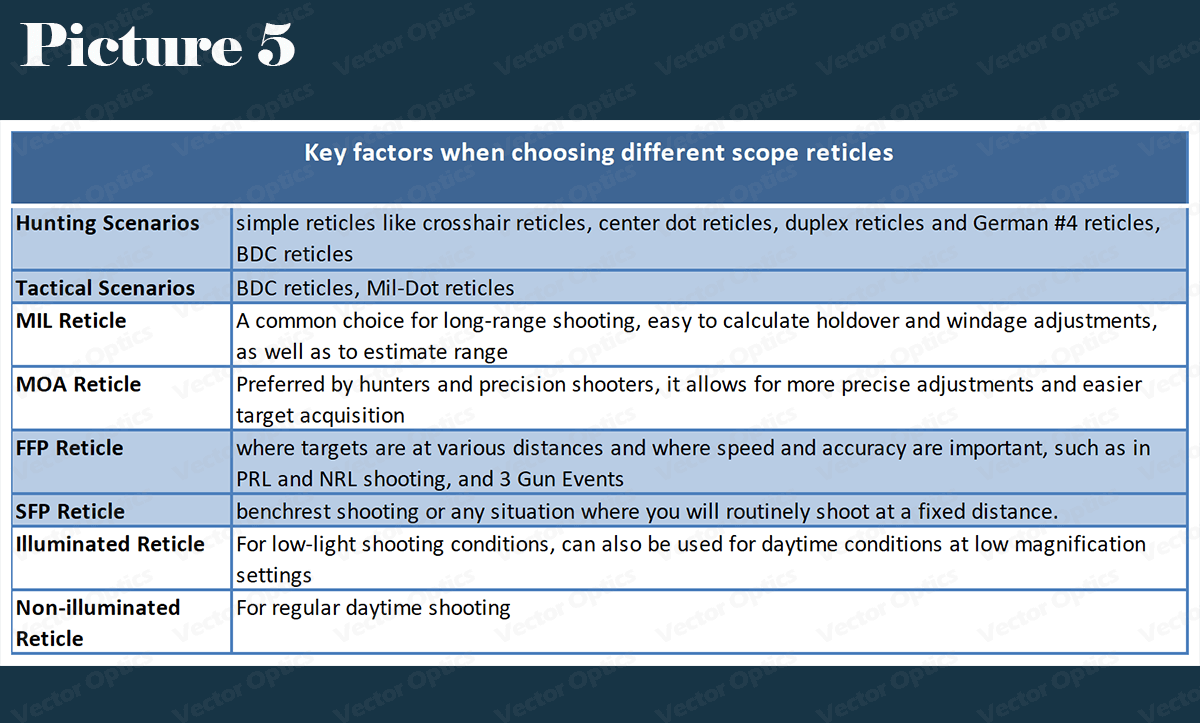
Evelyn: Yes, I understand that. Thanks for your help, Stephen.
Stephen: No problem, Evelyn. Next time I will explain in detail about different types of reticles and their usage.
Join our Facebook community to know more about Vector Optics!
